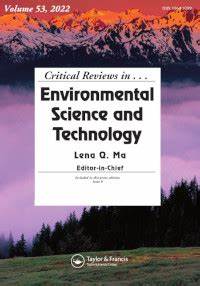Phytoremediation of indoor air: Mechanisms of pollutant translocation and biodegradation
IF 13.2
1区 环境科学与生态学
Q1 ENVIRONMENTAL SCIENCES
Critical Reviews in Environmental Science and Technology
Pub Date : 2025-05-19
DOI:10.1080/10643389.2024.2438444
引用次数: 0
Abstract
The built indoor environment, including domestic housing and commercial offices, has significantly lower air quality relative to ambient outdoor air. Methods of air purification typically rely on traditional mechanical filtration methods such as heating, ventilation and air conditioning systems, which are energetically intensive and require routine maintenance to ensure adequate filtration. To reduce energy demands and to improve urban sustainability, phytoremediation technologies have emerged as a promising method for the remediation of indoor air quality. Due to the need to identify and optimize sustainable methods to improve air quality, we present a comprehensive review on the mechanisms for plant-driven and microbial-driven removal of gaseous contaminants (i.e. volatile organic compounds) is warranted. The literature indicates that indoor air phytoremediation systems rely on complex of both the biological aspects (plant parts, substrate, microbial community, substrate moisture) and abiotic factors (airflow and moisture content), however it is evident that the method for optimal application of these factors within systems is currently significantly understudied, especially in relation to research done in-situ. The authors recommend future research directions should be targeted at plant biochemical analysis of phytoremediation systems exposed to real world pollutants like petroleum vapor, vehicle emissions, and mixed synthetic furnishings of-gassing, as well as the dynamics of the substrate microbial community within root systems. The assessment and developed understanding of these key areas are not only essential for the progression of the field of research but also for continued wide spread adoption for these phytoremediation systems.室内空气的植物修复:污染物转移和生物降解机制
建成的室内环境,包括住宅和商业办公室,相对于室外环境空气质量明显较低。空气净化的方法通常依靠传统的机械过滤方法,如加热、通风和空调系统,这些方法耗能大,需要日常维护以确保足够的过滤。为了减少能源需求和提高城市可持续性,植物修复技术已成为室内空气质量修复的一种有前途的方法。由于需要确定和优化可持续的方法来改善空气质量,我们对植物驱动和微生物驱动去除气态污染物(即挥发性有机化合物)的机制进行了全面的综述。文献表明,室内空气植物修复系统依赖于生物方面(植物部位、基质、微生物群落、基质水分)和非生物因素(气流和水分含量)的复合体,但很明显,目前对这些因素在系统内的最佳应用方法的研究明显不足,特别是与原位研究有关。作者建议未来的研究方向应该针对植物修复系统暴露于现实世界的污染物,如石油蒸汽,车辆排放和混合合成气体的植物生化分析,以及根系内基质微生物群落的动态。对这些关键领域的评估和深入了解不仅对研究领域的进展至关重要,而且对这些植物修复系统的持续广泛采用也至关重要。
本文章由计算机程序翻译,如有差异,请以英文原文为准。
求助全文
约1分钟内获得全文
求助全文
来源期刊
CiteScore
27.30
自引率
1.60%
发文量
64
审稿时长
2 months
期刊介绍:
Two of the most pressing global challenges of our era involve understanding and addressing the multitude of environmental problems we face. In order to tackle them effectively, it is essential to devise logical strategies and methods for their control. Critical Reviews in Environmental Science and Technology serves as a valuable international platform for the comprehensive assessment of current knowledge across a wide range of environmental science topics.
Environmental science is a field that encompasses the intricate and fluid interactions between various scientific disciplines. These include earth and agricultural sciences, chemistry, biology, medicine, and engineering. Furthermore, new disciplines such as environmental toxicology and risk assessment have emerged in response to the increasing complexity of environmental challenges.
The purpose of Critical Reviews in Environmental Science and Technology is to provide a space for critical analysis and evaluation of existing knowledge in environmental science. By doing so, it encourages the advancement of our understanding and the development of effective solutions. This journal plays a crucial role in fostering international cooperation and collaboration in addressing the pressing environmental issues of our time.

 求助内容:
求助内容: 应助结果提醒方式:
应助结果提醒方式:


